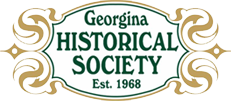Click to Download the PDF
Download the Word Doc
President’s Message
As the snowiest, coldest winter in recent memory draws to a close, brighter days are coming and we will soon replace snow shovels with gardening tools. As far as world events are concerned, events spinning both close to home and around the world remind us that history is being made every day. Who knows how things will shake out with the tariffs and federal elections on the horizon, hopefully our peaceful lives won’t be disrupted too much.
Closer to home, work continues behind the scenes at the Georgina Pioneer Village in anticipation of the Golden Anniversary celebrations, being held Saturday May 31th. The Village will be all spruced up and ready to welcome visitors and dignitaries alike. The Georgina Historical Society hopes to be well represented by our membership, and ask that you reserve the day. I’ll keep you posted as times and details become available.
The Village, now numbering 15 buildings, was started in 1975 by dedicated members of the GHS led by Nena Marsden. Money was raised through antique shows, Victorian teas, quilt raffles and sales of note cards to pay the bills, and with the support of enthusiastic town employees, town councillors and mayors, the Village as we know it slowly took shape. In 2006 the Society turned the Village over to the Town of Georgina, and it continues to thrive.
Our upcoming general meeting is being held at the schoolhouse at the Georgina Pioneer Village on Tuesday March 18, when our wonderful museum curator Melissa Matt will be giving us a virtual tour of the town of Virginia’s St. Anthony’s church cemetery. Melissa’s presentations are always entertaining, and I am looking forward to seeing you all there. As always, our meeting starts at 7pm, with meet and greet at 6:30. If you’ve never been out to one of our meetings, this will be a good one to attend.
That’s about it for me, I hope that this finds you well.
Paul Brady, President, Georgina Historical Society
Maple Sugar Time
By Bob Holden
It’s that time of year again when the sap will begin to flow in the maples ready for collection and rendering into sugar and syrup. An ancient process used long before the white man arrived, Indians were making sugar from maple sap well before contact with European explorers, missionaries or settlers. As early as the 1600s Jesuit missionaries noted the process in their Relations, a record of their time written before European settlement arrived in earnest
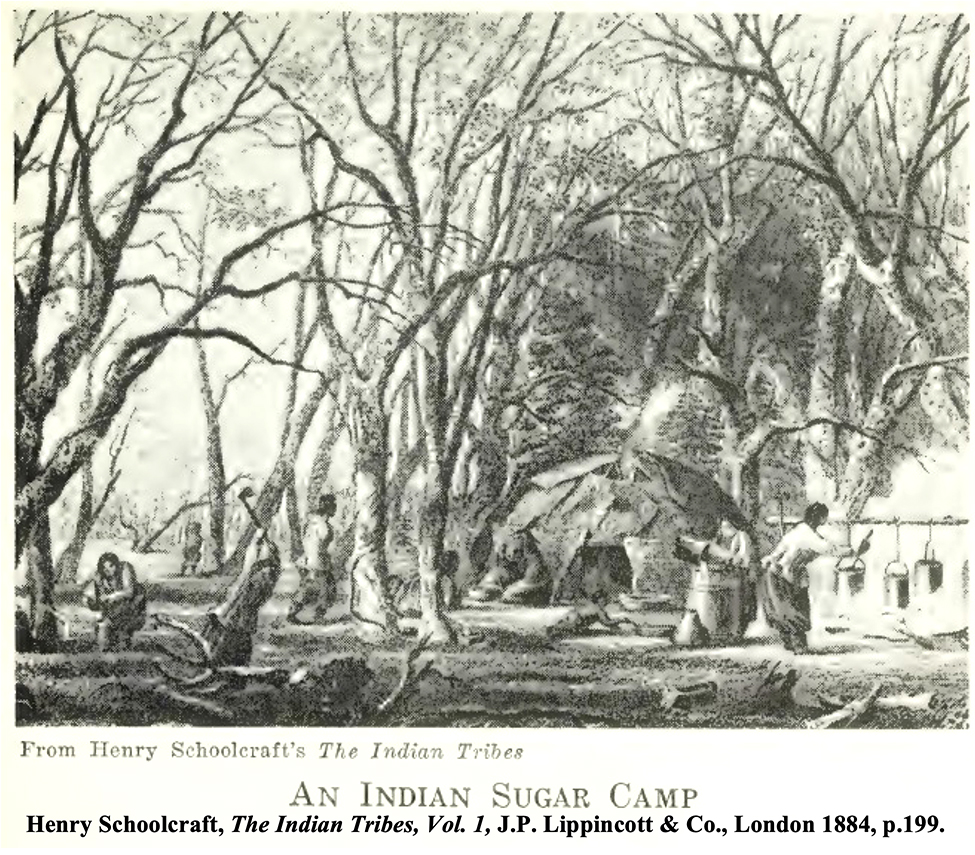
Before contact with Europeans, they would make a wooden trough by burning out a log, most often of basswood, then after scraping it clean with stone adzes, fill it with maple sap. Sap was collected by cutting a diagonal slash in the bark of a maple on the sunny side of the tree’s trunk. A piece of cedar was carved to make a spile to be inserted at the bottom of the slash and the sap would drain and drip into a bark receptacle for carrying it to the trough where it would then be deposited. Red hot stones would then be put into the trough to boil off the sap. It was a long and imperfect process to render the sap into sugar and syrup and the result was often watery and impure.
When the settlers first arrived they quickly learned about maple sugar from the Indians and improved on their methods by using metal pails to collect the sap and large metal kettles that could be hung over burning fires to heat and render the sap into sugar and syrup. Cane sugar was available at the time from some merchants domiciled in the larger communities and cities but was very expensive as it came from England or the United States; there were no sugar refineries in the British Colonies until 1854 when John Redpath opened the first sugar refinery in Montreal. The sugar was not granulated as a process for that had not yet been developed. Instead, it was cast into loaves which looked like hard bucket shaped cones and was broken off for use by using nippers. Inferior and moist crushed cane sugar packed into hogsheads was also available. But it often softened and became watery; often turning into molasses and sometimes became vinegary.

An early pioneer sugar camp; maple sugaring was a useful and economical project for an individual family.
Image from Metropolitan Toronto Library Board
The process for making maple sugar was hard work being labour and time intensive. Trees had to be tapped using an auger by punching holes about 1” into the sapwood usually on the sunny side of the tree trunk. Hollow spiles were driven into these holes and pails would be hung below the spiles to collect the sap daily from the trees. A settler’s sugar bush might have as many as several hundred trees to tap. Sap would be poured into a larger container carried on a sled or small wagon and carried to the sugar shack which was usually located centrally in the sugar-bush. There it would be deposited into barrels to be stored for later rendering. When the “sugaring-off” or rendering process began, sap would be poured into large kettles hung over fires to boil down into sugar and syrup. Once started the fires and rendering process was continuous and had to be constantly monitored to ensure its successful completion.
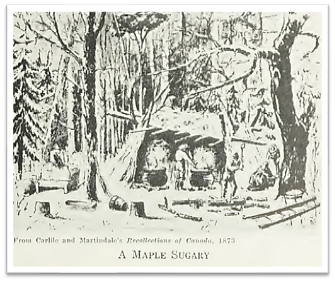
Collection often began as early as mid-March when the sap began to flow and continued on into the middle of April. Usually the settler and some of his neighbours would work together to tap the trees, collect the sap and prepare the sugar shack for use. Once sap was ready for rendering, the rest of the family and neighbours would get involved making it, as much a social occasion as a working bee.
Though most sap was rendered into sugar, settlers often made syrup to drizzle on bread and pancakes. It could also be used to make vinegar, beer or wine, while the sugar itself would be used to flavour cakes, puddings, tea and coffee. In 1849 Catharine Parr Traill noted in The Backwoods of Canada that children often made a sort of candy at the sugaring off by taking “a little of the thickest syrup into a saucer, stir in a very little fine flour, and a small bit of butter, and flavour with essence of lemon, peppermint, or ginger, as you like best; when cold, cut into little bricks about an inch in length. This makes a cheap treat for the little ones–you can always give them sweeties, if you think proper to allow them indulgences of this sort.”
Once rendered, the sugar would be poured into wooden molds holding 1, 2, or more pounds of the sugar for easy storage. The smaller molds were mostly used for home consumption, larger molds were used for commercial use. Greasing molds would facilitate the removal of the sugar loaf from the mold.
Today, many places still use the time-honoured methods of our early settlers to collect the sap but instead of great kettles slung over a fire, have turned to using a system of several boilers perched over an enclosed stove to direct and control the heat. Trees are still bored and tapped with spiles. However commercial operations now collect sap with plastic tubing directing it by pumps and gravity feed into central storage tanks for later rendering. Today it is possible to visit a number of nearby locations where the process of collection and rendering may be seen just as it was done over 100 years ago.
Check out the following nearby locations online for events and their times. Most will charge a fee of $10 to $14 which will usually include things like pancakes and samples of maple candy , syrup, and sugar.
Check out https://www.familyfuncanada.com/toronto/maple-syrup-festivals-ontario/.
Sources:
Edwin C. Guillet, Early Life in Upper Canada, The Ontario Publishing Company, Toronto 1933, Chapter VI. P. 252- 261
Images from Early Life in Upper Canada by Edwin C. Guillet, image plates between pp. 258 and 259
Sugar In Pioneer Ontario, April 5, 2017, https://flamboroughhistory.com/author/wefhs/
Gathering maple sugar the traditional Anishinaabe way https://thekidshouldseethis.com/post/making-maple-sugar-anishinaabe-tradition-video
Where in Georgina?
Here’s a new picture to study, it’s a little blurry but that adds to the fun. The old picture in the last several newsletters was the radial station at Keswick at Church Street and Metro Road. No prizes for guessing correctly, but we’ll put up your correct answer in the April’s newsletter for bragging rights!

St. Patrick’s Day in Canada
Over the centuries, St. Patrick’s Day has evolved from a solemn religious observance to a global celebration of Irish culture, marked by parades, music and festivities. St. Patrick’s Day began as a religious feast day in Ireland in the early 17th century, established by the Catholic Church. The day was marked by attending Mass and a break from Lenten restrictions, allowing celebrants to eat and drink. While originally religious, it has become a national celebration of Irish culture and heritage, featuring parades, festivals and traditional music.
Irish immigrants brought St. Patrick’s Day traditions to countries like the United States, Canada and Australia. It gained popularity as a celebration of Irish identity and pride, especially among immigrant communities. The first recorded St. Patrick’s Day parade took place in New York City in 1762, organized by Irish soldiers serving in the British Army. Today, cities worldwide, including Dublin, Montreal, Chicago and Sydney, host elaborate parades and events.
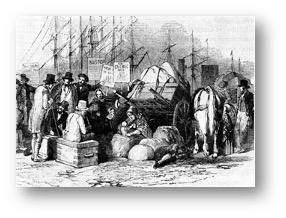
Irish emigrants wait with their few belongings to board ship for North America. Millions were forced to leave by famine.
From Illustrated London News, 10 May, 1851, p. 386. Courtesy of Library and Archives Canada, C-3904
Irish immigration to Canada began in the 17th century, with a significant increase during the 19th century. Many Irish settlers arrived during the Great Irish Famine (1845–1852), seeking refuge and new opportunities. Irish immigrants established strong communities, particularly in Newfoundland and Labrador, Nova Scotia, Quebec, and Ontario. In Ontario one of the larger settlements was established in the Peterborough area by Peter Robinson. They brought their traditions, including the celebration of St. Patrick’s Day, to Canada. Montreal’s St. Patrick’s Day Parade is one of the largest and longest-running in North America, dating back to 1824. Closer to home, St. Anthony’s Catholic Church in our village of Virginia has long been the spiritual home for much of our Irish community in Georgina.
Parades and celebrations spread to cities like Toronto, Ottawa and Halifax, where Irish communities were prominent. In Newfoundland and Labrador, St. Patrick’s Day became a public holiday, reflecting the province’s deep Irish roots
Lodges and other social organisations of the urban centres had also an influence on rural life. The National Societies of St. George, St. Patrick and St. Andrew, though organised in the towns, usually drew many members from the surrounding country and were long important in the social life of the communities.
Contemporary accounts of holiday celebrations show that excesses were expected, and that the authorities were surprised and quite obviously pleased when the day passed off without “bloody battles’, fatal accidents, or other un-toward incidents. In the rear concessions, particularly where the lumbering industry was prominent, serious trouble was frequently the result of holidays, fairs, or other occasions where rival elements in the population came together. Bytown and Richmond on the Ottawa were the scene of several such riots, and on many occasions clashes were very narrowly averted.
The National Societies of St. Patrick, St. George and St. Andrew – These organisations date from the earliest years of Upper Canada, for they were prominent in Niagara in the seventeen nineties. It was natural that such organisations should be formed at a time when many of the inhabitants of the province had come but recently from the Old Land. The feeling of nationality was strong, and the memories of former days amid very different surroundings were fondly treasured. The English, Irish and Scottish societies were at the height of their popularity in the late fifties and early sixties, when many of the first settlers of importance were still living, and before the growth of national feeling in Canada had received a strong impetus as a result of the Fenian Raids and the Confederation movement.
Secular celebrations have continued on into the modern era in Ontario. The Toronto Maple Leafs hockey team was known as the Toronto St. Patricks from 1919 to 1927, and wore green jerseys. In 1999, when the Maple Leafs played on Saint Patrick’s Day, they wore green St Patrick’s retro uniforms. Since 2019, the City of Waterloo, Ontario has had to contend with an ever-growing massive street party that has coincided with the Saint Patrick’s Day celebrations. So on March 17th, feel free to wear the green and celebrate our Irish heritage.
Sources:
Pioneer Days in Upper Canada, Guillet, University of Toronto reprinted 1964 pp. 160-176
https://excelnotes.com/holiday/st-patricks-day-canada/#history
https://en.wikipedia.org/wiki/Saint_Patrick%27s_Day
https://thecanadianencyclopedia.ca/en/article/st-patrick-s-day-in-canada
Georgina Historical Society’s February General Meeting
By Paul Brady
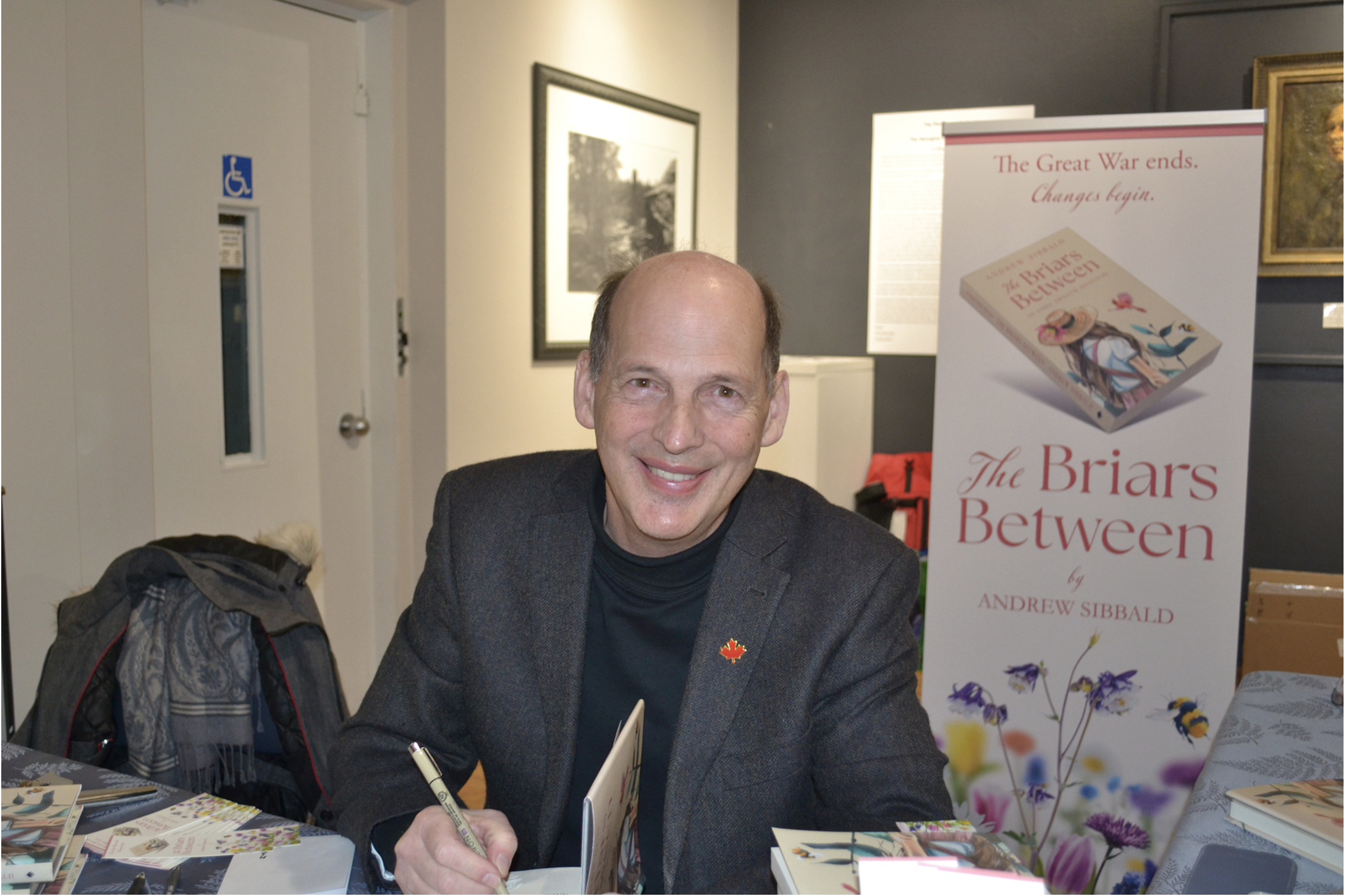
The Georgina Historical Society enjoyed a reading by Andrew Sibbald from his new novel, “The Briars Between”, at our general meeting this past February 18. Despite one of the nastiest weather events of the season we had a good turnout of listeners, and Andrew did a wonderful job of bringing us into Emily’s world. His well researched and entertaining novel is based in Jackson’s Point in 1919 and follows the adventures of Emily Twillum and her friends as they explore the world around them.
A big Thank You and congratulations on such a wonderful book go out to Andrew, and also to the Georgina Centre for Arts and Culture for hosting our evening. Everyone that I spoke to was glad that they braved the weather to attend this event.
If you would like a copy of Andrew’s novel there are copies available at the Georgina Centre for Arts and Culture, or visit: https://www.andrewsibbald.ca/
News
There is no information as yet on the hiring of a maintenance person for the Village. We have requested that the Town consider making this a full-time position as it would serve the needs of the Village much better. We have lost several good workers to full-time positions elsewhere requiring the training of a new person each year before they can get up to speed on the work.
Melissa Matt advises that digitization of archival resources will be done by summer students when they have time to do it.
Volunteers will be needed to man our refreshment booth at Music in the Streets and for our booth at the opening of the Village; details to follow on times and dates. Volunteers will also be needed to staff the buildings for the 50th anniversary celebrations on May 31st.
This year your Board has decided that the GHS will take a pass on Harvestfest for 2025. Kim Brady, our chair for the past three years, and Bob Holden, our music co-ordinator, have both been involved with it for the past several years and will not be available to do it this year. We have put out feelers for volunteers to take their places but no-one has come forward as yet. These are roles that involve considerable time and effort. Anyone coming forward would have to be prepared to commence working on this event immediately as once past March it becomes very difficult to arrange vendors and musicians.
Events
Tuesday, March 18 – General Meeting; GPV curator Melissa Matt will be giving a presentation and virtual tour of St. Anthony’s cemetery, and the meeting will held be at the schoolhouse at the Georgina Pioneer Village, meeting starts at 7pm, meet and greet at 6:30.
Monday April 7 – Board Meeting at 1:30 with the Town of Georgina and 2:00 pm regular meeting at the Schoolhouse in the Village.
April 15 – At our general meeting Former Georgina Mayor Rob Grossi will share stories of Georgina ; at the schoolhouse in the Georgina Village Museum. Meet & Greet 6:30 pm meeting at 7:00 pm.
Saturday May 31 – Golden Anniversary Celebration of the Georgina Village Museum at the Village all day.
